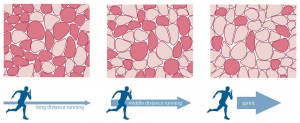Musculoskeletal system: building strength — DRAFT ONLY
Learning Objectives
Know why weight-bearing exercise protects against osteoporosis.
Know why weight training builds muscle bulk.
Know the difference between red meat and white meat (slow-twitch and fast-twitch).
Know why weight-bearing exercise protects against osteoporosis.
Muscle is a soft tissue in the body of humans and animals. The purpose of muscles is to produce force and motion. Both humans and animals’ bodies use muscles to help create movement and posture such as walking, sitting, eating, and other different kinds of movement. Muscles also help internal organs function. For example, the muscle helps heart pumping to circulate blood throughout the body.
Muscle makes up around half of the total human body weight. Muscle tissue is also around 15% denser than fat tissue. Particularly in the human body, there are around 650 skeletal muscles. Skeletal muscles are the muscles that control how a person creates any kind of moment whereas tendons connect the muscle between two bones across the joint. Tendon contracts the muscle and it moves the bones.

Weight lifting helps keep the bone strong to protect against osteoporosis. Weight lifting allows the muscles and tendons to pull the bones which make the bone cells think that it should produce more bone. There are two different ways that could help with creating muscle. To create and straighten muscle, exercises such as jogging or running are considered to be body weight to help create and tone muscle.
Know the difference between red meat and white meat (slow-twitch and fast-twitch).
Slow-twitch (type I) is the muscle that has red color and carries oxygen more efficiently by using fats, proteins, and carbs as energy. What makes the muscle slow-twitch is because the muscle fibers contract over a long period of time. By having oxygen run more efficiently, type I muscle fiber works best for long duration activities

Fast-twitch (type II) is the muscle that has white color. The reason for it being white is that it lacks myoglobin which is the oxygen carrying protein. Fast-twitch muscles contract much more quickly and more powerful than slow-twitch muscle therefore it works best for rapid and intense exercise such as sprinting and powerlifting. One problem with type II muscle is that it gets fatigued and injured quite more often.
Know why weight training builds muscle bulk.

Working out builds muscle bulk through a process where your body repairs itself. After working out, your body will replace the damaged muscle fibers through a cellular process, in which it combines muscle fibers to form new muscle protein strands. These muscle protein strands, known as myofibrils, become thicker to create muscle growth. Just a reminder, this process does not occur during weight training, but after when you are resting. During muscle growth, Satellite cells act like stem cells for your muscles, and when activated, they add more nuclei to your muscle cells for growth to happen. Muscle memory comes into play to be able to really bulk up. The more you practice, the more your muscles will become precise.
-
- Figure 1: website provided by the creator of this chapter: https://www.mensjournal.com/health-fitness/beginners-guide-weight-training/
In the website, no CC licensing information found. It is stated: personal use only
- Figure 2 : website provided by the creator of this chapter: https://t3athlete.com/blog/2016/8/15/training-for-speed-developing-fast-twitch-muscle-fibers
In the website, it is stated “All Rights Reserved.”
- Figure 3: website provided by the creator of this chapter: http://www.mirrorfriendly.com/nutrition/lean-bulk-build-muscle-without-getting-fat/
No licensing information found in the website

